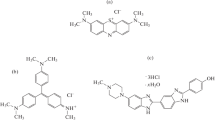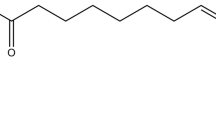Abstract
Determination of binding parameters such as the number of ligands and the respective binding constants require a considerable number of experiments to be performed. These involve accurate determination of either free and/or bound ligand concentration irrespective of the measurement technique applied. Then, an appropriate theoretical model is used to fit the experimental data, and to extract the binding parameters. In this work, the interaction between bovine serum albumin (BSA) and 1-anilino-8-naphthalene sulphonate (ANS) is revisited. Using steady state fluorescence spectroscopy, the binding isotherm of BSA/ANS was obtained applying the Halfman–Nishida approach. The binding parameters, site number, and binding site association constants, were determined from the stoichiometric Adair model and Job’s plot. The binding parameters obtained were then correlated to the distance of the respective binding site to the tryptophan residues using the energy transfer technique. This approach, that uses both tryptophans independently from each other, is presented as a tool to help understand the binding mechanism of the albumin fluorescent complex. The results show that ANS molecules bind to BSA in up to five different binding sites. Energy transfer from the tryptophan residues to the BSA/ANS complex shows that the four highest affinity binding sites (>104 M−1) are located at a reasonably close distance (18–27 Å) to at least one of two tryptophan residues, while the lowest affinity binding site (~104 M−1) is located over 34 Å away from the both tryptophans.





Similar content being viewed by others
References
He XM, Carter DC (1992) Atomic-structure and chemistry of human serum-albumin. Nature 358:209–215
Peters T (1985) Serum albumin. Adv Protein Chem 37:161–245
Kragh-Hansen U, Chuang VTG, Otagiri M (2002) Practical aspects of the ligand-binding and enzymatic properties of human serum albumin. Bio Pharm Bull 25:695–704
Harding SE, Chowdhry BZ (2001) Protein-ligand interactions: structure and spectroscopy. Oxford University Press, New York
Pacifici GM, Viani A (1992) Methods of determining plasma and tissue binding of drugs—pharmacokinetic consequences. Clin Pharmacokinet 23:449–468
Georgiou ME, Georgiou CA, Koupparis MA (1999) Automated flow injection gradient technique for binding studies of micromolecules to proteins using potentiometric sensors: application to bovine serum albumin with anilinonaphthalenesulfonate probe and drugs. Anal Chem 71:2541–2550
Birdsall B, King RW, Wheeler MR, Lewis CA, Goode SR, Dunlap RB, Roberts GCK (1983) Correction for light-absorption in fluorescence studies of protein-ligand interactions. Anal Biochem 132:353–361
Eftink MR (1997) Fluorescence methods for studying equilibrium macromolecule-ligand interactions. Meth Enz 278:221–257
Weber G, Young LB (1964) Fragmentation of bovine serum albumin by pepsin.1. Origin of acid expansion of albumin molecule. J Biol Chem 239:1415–1423
Cardamone M, Puri NK (1992) Spectrofluorometric assessment of the surface hydrophobicity of proteins. Biochem J 282:589–593
Haskard CA, Li-Chan ECY (1998) Hydrophobicity of bovine serum albumin and ovalbumin determined using uncharged (PRODAN) and anionic (ANS(-)) fluorescent probes. J Agric Food Chem 46:2671–2677
Hazra P, Chakrabarty D, Chakraborty A, Sarkar N (2004) Probing protein-surfactant interaction by steady state and time-resolved fluorescence spectroscopy. Biochem Biophys Res Commun 314:543–549
Bagatolli LA, Kivatinitz SC, Fidelio GD (1996) Interaction of small ligands with human serum albumin IIIA subdomain. How to determine the affinity constant using an easy steady state fluorescent method. J Pharm Sci 85:1131–1132
Matulis D, Lovrien R (1998) 1-anilino-8-naphthalene sulfonate anion-protein binding depends primarily on ion pair formation. Biophys J 74:422–429
Naik DV, Paul WL, Threatte RM, Schulman SG (1975) Fluorometric-determination of drug-protein association constants—binding of 8-anilino-1-naphthalenesulfonate by bovine serum-albumin. Anal Chem 47:267–270
Huang CY (1982) Determination of binding stoichiometry by the continuous variation method: the job plot. Meth Enz 87:509–525
GlaxoSmithkline. http://www.expasy.org/spdbv/
van Holde KE, Johnson WC, Ho PS (1998) Principles of physical biochemistry. Prentice Hall, Englewood Cliffs, NJ
Scatchard G (1949) The attractions of proteins for small molecules and ions. Ann NY Acad Sci 51:660–672
Fletcher JE, Spector AA, Ashbrook JD (1970) Analysis of macromolecule-ligand binding by determination of stepwise equilibrium constants. Biochem 9:4580–4587
Klotz IM (1974) Protein interactions with small molecules. Acc Chem Res 7:162–168
Klotz IM, Hunston DL (1984) Mathematical models for ligand-receptor binding. Real sites, ghost sites. J Biol Chem 259:60–62
Halfman CJ, Nishida T (1972) Method for measuring the binding of small molecules to proteins from binding-induced alterations of physical–chemical properties. Biochem 11:3493–3498
Lipskier JF, Tran-Thi TH (1993) Supramolecular assemblies of porphyrins and phthalocyanines bearing oppositely charged substituents—1st evidence of heterotrimer formation. Inorg Chem 32:722–731
De S, Girigoswami A, Das S (2004) Fluorescence probing of albumin–surfactant interaction. J Coll Int Sci 285:562–573
Brocklehurst JR, Freedman RB, Hancock DJ, Radda GK (1970) Membrane studies with polarity-dependant and excimer-forming fluorescent probes. Biochem J 116:721–731
Axelsson I (1978) Characterization of proteins and other macromolecules by agarose-gel chromatography. J Chromatog 152:21–32
Putnam FW (1975) The plasma proteins: structure, function and genetic control, vol 1, 2nd edn. Academic, New York
Lakowicz JR (1999) Principles of fluorescence spectroscopy, 2nd edn. Academic, New York
Moens PDJ, Helms MK, Jameson DM (2004) Detection of tryptophan to tryptophan energy transfer in proteins. Protein Journal 23:79–83
Petitpas I, Grune T, Bhattacharya AA, Curry S (2001) Crystal structures of human serum albumin complexed with monounsaturated and polyunsaturated fatty acids. J Mol Biol 314:955–960 (PDB ID: 1gnj)
Ghuman J, Zunszain PA, Petitpas I, Bhattacharya AA, Otagiri M, Curry S (2005) Structural basis of the drug-binding specificity of human serum albumin. J Mol Bio 353:38–52
Bagatolli LA, Kivatinitz SC, Aguilar F, Soto MA, Sotomayor P, Fidelio GD (1996) Two distinguishable fluorescent modes of 1-anilino-8-naphtalenesulfonate bound to human albumin. J Fluoresc 6:33–40
Togashi DM, Ryder AG (2006) Time-resolved fluorescence studies on bovine serum albumin denaturation process. J Fluoresc 16:153–160
Teale FWJ (1960) The ultraviolet fluorescence of proteins in neutral solution. Biochem J 76:381–388
Acknowledgement
This work was supported by Science Foundation Ireland under Grant number (02/IN.1M231)
Author information
Authors and Affiliations
Corresponding author
Appendix
Appendix
The critical radius, R 0, in Förster resonance energy transfer is defined as the distance at which the efficiency of energy transfer is equal to 50%. It can be calculated using the following expression [29]
with R 0 in Å, κ 2 is the orientation factor (two-thirds assumed) describing the relative orientation in space of the transition dipoles of the donor (Trp residues) and acceptor (ANS), and \(\phi _{\text{D}}^{\text{0}} \) is the donor fluorescence quantum yield in the absence of the acceptor. In the case of tryptophans in BSA this value is 0.15 [35]. A value of 1.33 is assumed for the refractive index, n, of the solution. The spectral overlap integral J(λ) between the donor emission spectrum and the acceptor absorbance spectrum was approximated by:
where, F D(λ) is the normalized fluorescence spectrum of the donor and ε A(λ) is the absorption molar extinction coefficient.
The distance between the donor and acceptor R DA can be determined by measuring the change in donor fluorescence. The donor fluorescence intensity was measured in the absence (I D) and in the presence of acceptor (I DA). Then, FRET efficiency can be calculated using the following expressions:
Rights and permissions
About this article
Cite this article
Togashi, D.M., Ryder, A.G. A Fluorescence Analysis of ANS Bound to Bovine Serum Albumin: Binding Properties Revisited by Using Energy Transfer. J Fluoresc 18, 519–526 (2008). https://doi.org/10.1007/s10895-007-0294-x
Received:
Accepted:
Published:
Issue Date:
DOI: https://doi.org/10.1007/s10895-007-0294-x




